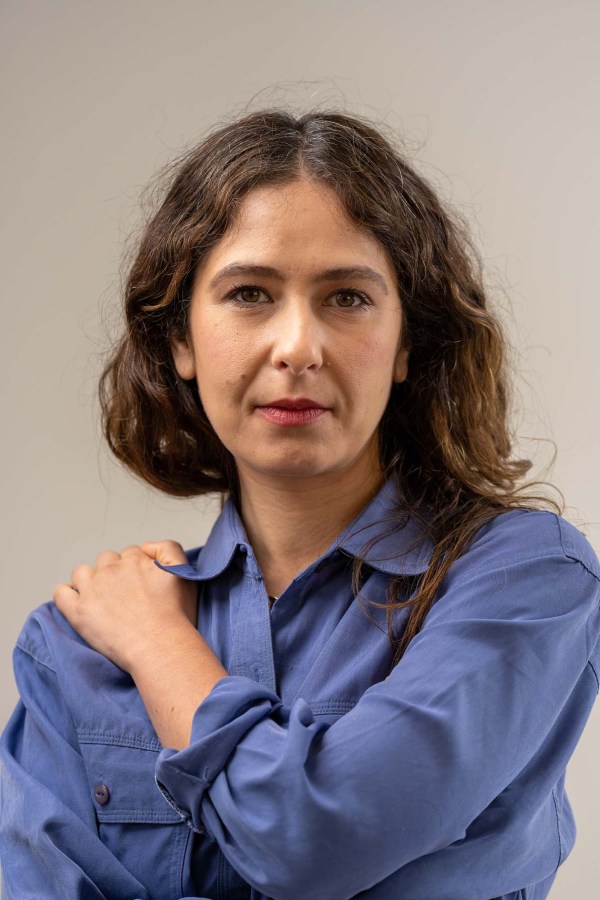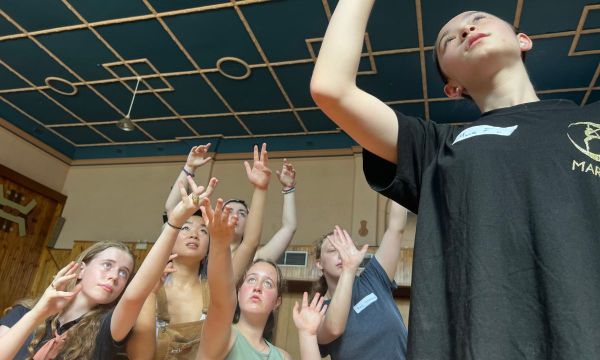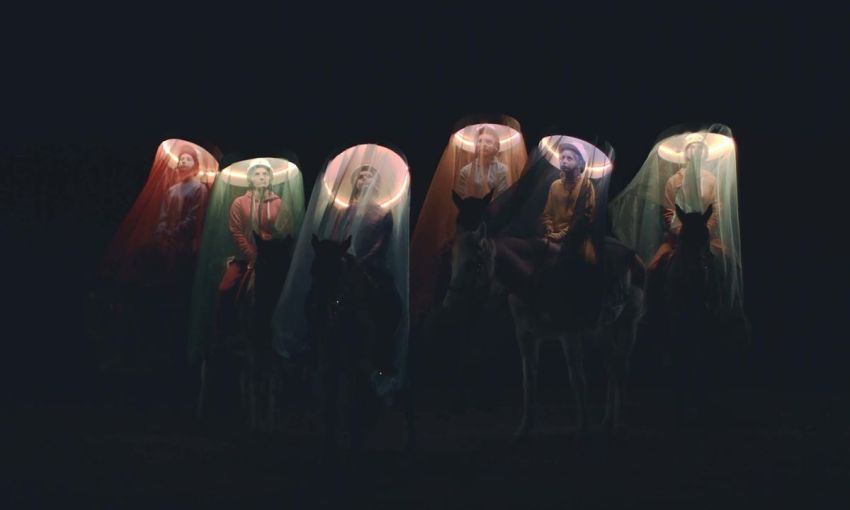Artist Tina Stefanou is making people rethink pony clubs in her work featured in the Art Gallery of South Australia's Adelaide Biennial.
The artist breaking down horse girl stereotypes
When Tina Stefanou was first invited to participate in the Adelaide Biennial of Australian Art: Inner Sanctum exhibition by curator José Da Silva, she thought it was spam.
“It was quite a significant opportunity and not one that I could foresee… so it was a lovely surprise to be invited,” Tina says.
Tina is a visual artist who has been a vocalist most of her life. Her work Hym(e)nals which features in the Inner Sanctum exhibition combines her two specialisations, using sound and video to tell a coming-of-age story focusing on interspecies communication.
Hym(e)nals is a 360-degree panoramic video that features seven young women aged between 13 and 21 and six elderly horses. The women dress each other in illuminated silk headdresses and lead the horses through the dark setting, laughing and humming together.
The name of the work, Hym(e)nals combines a vocal hymn with the anatomic hymen, referencing a pre-sexual moment in the riders lives.
Tina says prolific cliches that reduce pony clubs and the girls that participate in them as trivial can blind people from what’s really taking place.
“It’s really extraordinary to watch young girls know how to communicate with these large animals and we shouldn’t take that for granted just because it’s normalised and cliché,” Tina says.
“That is actually a super amazing skill, to be able to build a listening capacity and sensorial capacity with a creature that’s like five times your size.
“It’s actually extremely empowering for young women to participate in these activities with horses, as long as the welfare of the horses is number one, which it is at Jocklebeary Farm.”

Tina has made three works in her time working with Jocklebeary farm, including the 2019 work Horse Power, in this picture. Picture credit: Andrew Kaineder
Victoria’s Jocklebeary Farm, on Wurundjeri Woi-wurrung country, looks after rescue horses and is about 11 minutes from Tina’s home.
Tina has been working with the farm for about 10 years, which is run by an equine specialist named Sacajawea.
“I met her and we became very close friends, and it was through that closeness that she introduced me to her horses, and I began singing with them and humming with them, and it was very natural,” she says.
Many of the pony club girls in her work are neurodiverse and come to the farm for NDIS equine therapy. For the vocal component of the artwork, Tina ran vocal workshops to help them increase their lung capacity and their singing ability to communicate with the horses more effectively.
“So the voices in this work are all the young girls who were very shy to sing at first,” she says.

Tina is an early career artist who lives on Wurundjeri-Willam Country, Wattle Glen, Victoria. This picture: Rhett Hammerton
“I incorporated these techniques to help them find ways to feel stronger in using their voice and less self-conscious,” she says.
“Even as a professional vocalist, if someone asked me to sing right now I will have that moment of like, ‘oh shit, I’m about to be heard’ and this thing of being heard is such a strong thing.
“So the girls over time they got past the self-consciousness, they got past the shyness and the giggles and they started inventing their own sonic language… that is actually the beauty of the work.”
As well as the rhythmic hums of the girls, the soundscape includes bats, crickets and night birds, immersing viewers in the environment.
Tina says sound is an important component in building a relationship with horses.
“It’s what tells the horses where to go, when to stop, slow down, calm down. The hum is going through the body and vibrating and connecting to the horse’s body, so it’s tactile not just oral,” she says.
Tina’s work is more concerned with capturing the existing relationship between the girls and the horses, rather than choreographing a relationship.
She says it is practised in the sense that they prepare for filming. One of the ways she did this was riding the horses herself with the long transparent fabrics worn in the film, to make sure the horses were okay with it and to get used to it.
While she places them in the shots, what is captured is what actually happened, which for Tina “is where the magic of making is”.
Dance the War of Proximity
Mount Lofty Lookout
Wednesday, April 24, 12pm ’til 1:30pm
Adelaide Botanic Garden at the Amazon Water Lily Pavilion, Palm House and the Bicentennial Conservatory
Friday, April 26 1pm ’til 2:30pm
Adelaide Zoo
Saturday, April 27 2pm ’til 3.30pm
AGSA, Gallery 13
Sunday, April 28 3pm ’til 4pm.
For Tina, time is the crucial ethical component of her work with animals, and she prioritises long-term engagement beyond aesthetic outcomes.
“The ethics is that time of constant engagement and that’s where the accountability and the permission to collaborate exists and it’s an ongoing conversation,” she says.
Tina hopes viewers will stay with her Inner Sanctum for longer than 30 seconds.
“I think that is the average kind of gaze that people give a work and when you’re working with slow processes and different bodies, I think ‘what’s the responsibility of the audience?’ I always question that.
“Any person who asks an ethical question about working with horses, well, I would say how long have you spent with the work? I encourage that as being accountable.”
As an extension of Hym(e)nals, Tina has been producing a work called Dance the War of Proximity which explores interspecies class struggles and disparities in Australian societies.
“The equine space can be a problematic space in terms of classism, racism, all of those types of isms,” Tina says.

Tina’s workshops with young Adelaide performers to prepare for Dance the War of Proximity.
Dance the War of Proximity will feature 12 teenage performers from Adelaide exploring coming-of-age politics in natural settings at Mount Lofty Botanic Garden, Adelaide Botanic Garden and Adelaide Zoo before ending at the Art Gallery.
Tina has been working with the teens throughout March and April teaching vocals and movement, and she says it’s self-organised, with the teens dictating how they put together what they’ve learned.
She says they’ll represent a moving archive built with the interests they’ve raised at the workshops, like pop culture references, TikTok dances and elements of modern history.
Dance the War of Proximity is playing at differing locations from April 24-28 and is free at all performance locations except the Adelaide Zoo. Use the code ‘BIENNIAL’ at the main entrance to get a two-for-one ticket offer after midday at the zoo.




